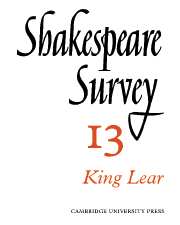Book contents
- Frontmatter
- The Catharsis of King Lear
- Lear’s Last Speech
- Albany
- Madness in King Lear
- The Influence of Gorboduc on King Lear
- Some Aspects of the Style of King Lear
- Keats and King Lear
- King Lear on the Stage: A Producer’s Reflections
- Costume in King Lear
- The Marriage-Contracts in Measure for Measure
- Tom Skelton—A Seventeenth-century Jester
- Illustrations of Social Life III: Street-Cries
- An Elizabethan Stage Drawing?
- Was there a Music-room in Shakespeare’s Globe?
- International Notes
- Shakespeare Productions in the United Kingdom: 1958
- Three Adaptations
- The Year's Contributions to Shakespearian Study 1 Critical Studies
- 2 Shakespeare’s Life, Times and Stage
- 3 Textual Studies
- Books Received
- Index
- Plate Section
2 - Shakespeare’s Life, Times and Stage
Published online by Cambridge University Press: 28 March 2007
- Frontmatter
- The Catharsis of King Lear
- Lear’s Last Speech
- Albany
- Madness in King Lear
- The Influence of Gorboduc on King Lear
- Some Aspects of the Style of King Lear
- Keats and King Lear
- King Lear on the Stage: A Producer’s Reflections
- Costume in King Lear
- The Marriage-Contracts in Measure for Measure
- Tom Skelton—A Seventeenth-century Jester
- Illustrations of Social Life III: Street-Cries
- An Elizabethan Stage Drawing?
- Was there a Music-room in Shakespeare’s Globe?
- International Notes
- Shakespeare Productions in the United Kingdom: 1958
- Three Adaptations
- The Year's Contributions to Shakespearian Study 1 Critical Studies
- 2 Shakespeare’s Life, Times and Stage
- 3 Textual Studies
- Books Received
- Index
- Plate Section
Summary
In her genial history of Charlecote, Alice Fairfax-Lucy makes the most of the supposed connection between Shakespeare and Sir Thomas Lucy, but with proper brevity. The family and the house, which remained relatively unaffected by, and isolated from, major wars and political changes until modern times, are the theme of a book which celebrates the attachment of the country gentleman to his land. The author has a good deal of quiet fun with the mediocrity or downright silliness of many of the Lucys, but writes charitably, and out of a deep affection for a way of life that has all but passed. Shakespeare removed himself from their influence by going to London, but he no doubt took some Stratford mannerisms with him, and Hilda Hulme provides some further examples of local usages and dialectal forms which may help to explain obscurities in the poet’s language. The sonnets seem to reflect something of Shakespeare’s early life in London, but the identity of the youth addressed remains a mystery; Dick Taylor Junior, illustrating the ambition and forcefulness of the Earl of Pembroke from the age of 15 when he came to court, seeks to show that he ‘in no way resembled any of the several youths who might be extracted from the Sonnets as they were printed in 1609’.
- Type
- Chapter
- Information
- Shakespeare Survey , pp. 154 - 161Publisher: Cambridge University PressPrint publication year: 1960

